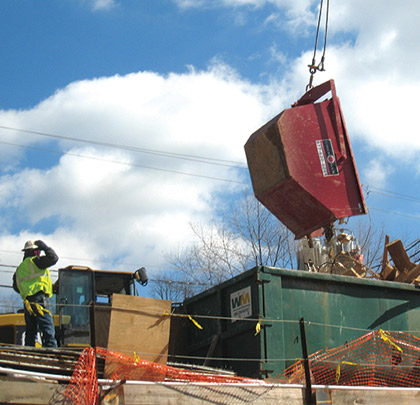The Occupational Safety and Health Administration (OSHA) posts, “All employers are to provide their employees with a worksite free from recognizable hazards that could cause injury or death.” Trash removal on a jobsite under the best of conditions is a messy proposition. The act of tossing or loading debris in a bin, then flying the container by crane from the top of a high-rise structure to a dumpster on ground level seems contrary to the abovementioned OSHA statement. Jobsite cleanup, however time-consuming, is necessary.
In today’s fast-track construction climate, “time is money” means more than ever before. After all of the jobsite gymnastics involved with loading a bin, rigging it to a crane, swinging it over a dumpster, and dumping it, often the most dangerous part hasn’t even occurred. It is when a man gets in the debris-filled dumpster to unchain the bin that the potential for accidents is most prevalent. Enter a new method of debris removal that relieves a lot of the danger while cutting a big chunk of time out of the cleanup equation: the self-dumping bin (SDB) which, in today’s business language, translates to a win-win.
SELF-DUMPING BIN PROVIDES SOLUTION
For those who have been using cobbled-together garbage bins or conventional bins that require a four-point rigging system, the SDB is a safety director’s dream come true. The primary problem with trash removal is that someone has to climb into a dumpster to remove rigging to empty the bin. Construction personnel are walking in nails, broken glass, rebar, wood, paint cans, etc. Falls are common and lead to cuts, abrasions, and punctures. When employees climb on—and jump down from—6- to 8-foot-high icy or wet dumpsters, ankle, knee, and back injuries are the result. These are avoidable OSHA-recordable injuries.
The second issue with homemade bins is their load rating. These bins are often loaded with concrete, wood, sheetrock, steel, and other heavy construction waste. With no weight rating, construction personnel have no capacity guidelines. Bins have failed and collapsed due to overloading on several projects. These homemade bins also require costly rigging. On most designs, a set of four-way cables are needed, along with four shackles—one for each corner. This rigging can cost up to $800 per bin. Furthermore, the cables become frayed or damaged and must be replaced at additional cost.
SOLUTION EQUALS SAFETY
The introduction of the new SDBs eliminates all of the situations, problems, and costs listed above. SDBs are quite simple in their operation. They have a single arm that rotates to the vertical position when hoisted. The arm cannot go past center because of stops mounted to the outside of the bin. The bin is sloped in the front for the following reasons:
- Easier removal of debris, which slides out rather than flipping out on many traditional bins
- Bin’s slope keeps debris toward the back of the bin to prevent tipping
- Construction personnel can remove bin from the hoisting mechanism with no need for personnel to climb into the dumpster
Once the bin is lowered to the ground or into the trash receptacle, the crane operator cables down, allowing the arm to lay back. Once the arm reaches the back of the bin, a dog bone swivels to lock the arm in place. The crane operator can then cable up to dump the debris. The bin can be carried away in the vertical position to the next location. When lowered to the ground, the slope on the front automatically lays it into the correct position.
SELF-DUMPING BINS IN ACTION
On a project in Atlanta, Georgia, conventional garbage bins were tested against the new SDBs. The old-style, homemade bins took two men to attach the rigging and one man to climb into the dumpster to remove the rigging. The time taken to attach the bin to the tower crane, dump it, then released it totaled 9 minutes of crane time. The SDB took one man to attach the rigging and one man to remove the rigging. Once connected to the crane, dumped, then released, the total crane time needed was 2 minutes. On this project, they were dumping an average of three bins an hour. This constituted 27 minutes of valuable crane time saved for other duties.
Hugo Hernandez, project manager for Form Works, the concrete contractor on the 67-story Marquis Condominium Tower project in West Palm Beach, Florida, is a believer. “No one is climbing around in the trash to re-hook the rigging,” he says. “It is all done by radio communications with the crane operator. Cleanup from 15,000-square-foot decks, which are more than 800 feet in the air, means saving crane time is critical. Simply rigging with just two chains instead of four saves a lot of time. And we only remove the chains half as much since it is self-dumping.”
GETTING TO THE BOTTOM LINE
The new SDBs serve multiple purposes; the self-dumping mechanism eliminates the need for project personnel to climb in and out of jobsite dumpsters—which reduces the risk of injuries—and a single pick point replaces costly shackles and rigging. The quicker cycles of self-dumping bins save on crane time. These bins have engineer certified weight ratings. “The difference in our guys’ attitudes about cleanup is phenomenal,” says Bryan Larson, field operations manager for Keystone Structural Concrete in Houston, Texas. “In the time we have been using them, cleanup is faster and the men appreciate staying out of the dumpsters. We have two and ordered two more.” ■
For More Information: To view a video of a self-dumping bin in action, visit www.cherokeepumping.com. For more information, call 877.620.6094.
_________________________________________________________________________
Modern Contractor Solutions – December 2015
Did you enjoy this article?
Subscribe to the FREE Digital Edition of Modern Contractor Solutions magazine.



